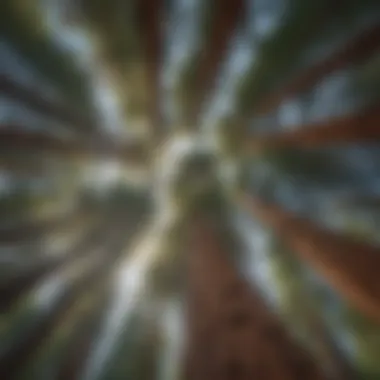Unveiling the Majestic Splendor of Sequoia Trees: A Dive into Nature's Giants


Evergreen Trees Species
Sequoia trees, the giants of the forest world, stand as magnificent representatives of evergreen trees in American forests. Their towering presence and unparalleled grandeur make them a focal point in the realm of forestry professionals and academics. The unique characteristics of sequoias, such as their colossal height and impressive girth, showcase the resilience and longevity of these awe-inspiring natural wonders.
Ecological Significance
Delving into the ecological significance of sequoia trees unveils a wealth of benefits that these evergreens contribute to their forest ecosystems. From providing habitat for diverse wildlife species to enhancing soil stability and nutrient cycling, sequoias play a vital role in maintaining ecological balance. Their ability to sequester carbon and purify the air further accentuates their importance in combating climate change and promoting environmental sustainability.
Conservation Practices
Efforts to safeguard and preserve sequoia trees involve a multifaceted approach that incorporates conservation practices tailored to their unique needs. Conservation methods such as controlled burns to mimic natural fire cycles, genetic diversity preservation, and habitat restoration projects aim to ensure the longevity of sequoia populations. Collaborative conservation initiatives involving government agencies, environmental organizations, and local communities play a crucial role in securing the future of these majestic trees.
Forest Management Techniques
Management practices for sequoia forests encompass a range of strategies focused on wildlife habitat preservation, sustainable logging, fire prevention, and ecosystem restoration. Wildlife habitat preservation involves maintaining biodiversity through habitat connectivity and protected areas. Sustainable logging practices prioritize responsible timber harvesting methods to minimize environmental impact and promote long-term forest health. Fire prevention measures include early detection systems and controlled burning to mitigate the risk of catastrophic wildfires, while ecosystem restoration initiatives aim to rehabilitate degraded lands and promote ecological resilience.
Climate Change Impact on Evergreen Forests
The impact of climate change on evergreen forests, including sequoia ecosystems, is a pressing concern necessitating proactive mitigation efforts. Understanding the role of forests in carbon sequestration and climate regulation is essential in combating climate change. Weather pattern shifts influenced by climate change can have cascading effects on forest ecosystems, altering species distributions and ecosystem dynamics. Exploring the localized effects of climate change on sequoia forests sheds light on the interconnectedness between environmental changes and forest health.
Management and Preservation of Evergreen Forests
Preserving the rich heritage of American evergreen forests, including sequoia stands, requires a nuanced approach that integrates historical knowledge, research insights, and conservation efforts. Reflecting on the historical context of these forests and indigenous practices underscores the importance of traditional ecological wisdom in modern conservation endeavors. Presenting the latest research findings on evergreen forests, from biodiversity studies to sustainable management techniques, informs ongoing conservation practices and policy development. Highlighting successful conservation efforts showcases the collaborative spirit and dedication of stakeholders working towards safeguarding the legacy of American evergreen landscapes.
Outdoor Activities in Evergreen Forests
Beyond their ecological significance, evergreen forests provide a sanctuary for outdoor enthusiasts seeking immersive experiences in nature. Serene hiking trails wind through sequoia groves, offering hikers a glimpse into the ancient majesty of these towering trees. Camping destinations amidst evergreen landscapes provide a chance to reconnect with the wilderness and appreciate the untamed beauty of forested terrains. Nature photography enthusiasts can capture stunning images of sequoias and their surroundings, showcasing the timeless allure of these natural wonders. Birdwatching enthusiasts are treated to a symphony of avian melodies in prime birdwatching areas within evergreen forests, adding a layer of biodiversity exploration to outdoor adventures.
Understanding Sequoia Trees
In the realm of exploring the monumental stature of sequoia trees, delving into the profound essence of Understanding Sequoia Trees is pivotal. This section acts as the foundation stone for unraveling the majestic dominance of these natural giants, providing insights into their unique characteristics and ecological significance. Understanding Sequoia Trees offers a comprehensive lens through which we can appreciate the grandeur and splendor of these ancient arboreal wonders. By examining their intricate features and roles in the ecosystem, we gain a profound appreciation for the essence of these colossal organisms.
Introduction to Sequoia Trees
Brief Overview of Sequoia Species


The Brief Overview of Sequoia Species serves as a gateway to comprehending the sheer magnificence of these towering entities. Discussing the lineage and distinct attributes of various sequoia species, this aspect accentuates the evolutionary marvel that defines these iconic trees. By highlighting the unique features and growth patterns specific to different sequoia species, we gain a deeper understanding of their intricate genetic makeup and biological diversity. This overview sets the stage for a nuanced exploration of the varied dimensions of sequoia trees present in this article.
Historical Significance
The Historical Significance segment delves into the ancestral narrative woven by sequoia trees through the ages. Examining the cultural and historical implications of these majestic beings, we uncover the rich tapestry of myth and legend that surrounds their legacy. From the sacred reverence of indigenous communities to their symbolic representation in human history, the historical significance underscores the profound impact of sequoia trees on diverse civilizations. By tracing their legacy through time, we grasp the enduring importance and symbolic resonance that sequoias hold in the collective consciousness.
Features and Characteristics
Distinctive Bark Patterns
Exploring the Distinctive Bark Patterns of sequoia trees unveils a mesmerizing tapestry of natural design and functionality. The intricate patterns and textures etched into their bark not only serve as a visual marvel but also play a crucial role in their survival strategies. By dissecting the composition and protective properties of sequoia bark, we gain a holistic perspective on the evolutionary adaptations that have enabled these trees to thrive for millennia. Understanding the symbiotic relationship between bark patterns and environmental challenges enhances our admiration for the resilience encoded within the fabric of sequoia trees.
Needle Structure
The Needle Structure of sequoia trees represents a botanical marvel that contributes to their unparalleled longevity and vitality. By elucidating the anatomical intricacies of sequoia needles, this section sheds light on the physiological mechanisms that enable these trees to endure harsh environmental conditions. From nutrient absorption to transpiration processes, the needle structure plays a fundamental role in the overall health and vigor of sequoia trees. Understanding the adaptive qualities of their needle structure illuminates the ingenious mechanisms that have sustained these arboreal behemoths over centuries.
Ecosystem Importance
Role in Forest Ecology
The Role in Forest Ecology section underscores the indispensable contribution of sequoia trees to the intricate web of forest ecosystems. By elucidating their role as keystone species and ecosystem engineers, we recognize the profound impact that sequoias exert on biodiversity and habitat stability. Through seed dispersal, shade provision, and nutrient cycling, these iconic trees play a multifaceted role in shaping forest dynamics and promoting ecological resilience. Appreciating the interconnectedness of sequoias within forest ecosystems enriches our understanding of their ecological significance and underscores the need for conservation efforts to preserve their vital ecological functions.
Environmental Impact
Examining the Environmental Impact of sequoia trees reveals the far-reaching implications of their presence on the broader landscape. From carbon sequestration to soil stabilization, sequoias exhibit a remarkable capacity to mitigate environmental pressures and enhance ecosystem health. By analyzing their role in combating climate change and fostering biodiversity, we grasp the critical importance of safeguarding sequoia populations for environmental sustainability. The environmental impact of these majestic trees serves as a poignant reminder of the interconnectedness between nature and human well-being, advocating for conscientious stewardship of these natural treasures.
Physical Dimensions
In this detailed exploration of sequoia trees, the section focusing on Physical Dimensions holds significant importance. By delving into the towering height, impressive girth, and remarkable mass of these majestic trees, we unravel the very essence of their magnificence. Understanding the physical dimensions of sequoias provides a profound insight into the sheer grandeur of nature and serves as a gateway to appreciating the intricate details that make these trees truly exceptional.
Height
Comparison to Skyscrapers
The comparison of sequoia tree heights to skyscrapers is a compelling way to contextualize their impressive stature. Delving into this comparison not only showcases the remarkable natural engineering of these trees but also highlights the astounding heights they can reach. Exploring how these living giants stand tall in comparison to man-made structures reveals the sheer scale of their existence and offers a unique perspective on vertical growth in nature. This comparison adds a fascinating dimension to our understanding of sequoias and underscores their unmatched height in the natural world.


Tallest Sequoia Recorded
Examining the tallest sequoia tree ever recorded provides a concrete example of the awe-inspiring heights these trees can achieve. Unraveling the story behind the tallest sequoia unveils the journey of growth and resilience that characterizes these ancient organisms. By studying the tallest of their kind, we gain insights into the exceptional genetic potential and environmental factors that contribute to such colossal growth. Understanding the nuances of the tallest sequoia recorded enriches our appreciation for the extraordinary heights that these botanical wonders can reach.
Girth and Diameter
Impressive Circumference Measurements
Diving into the impressive circumference measurements of sequoia trees offers a glimpse into the sheer magnitude of their girth. These measurements not only reflect the physical robustness of these trees but also hint at the age and vitality hidden within their massive trunks. Exploring the impressive girth of sequoias allows us to visualize their substantial presence in the forest ecosystem and appreciate the monumental scale at which they thrive. Understanding the circumference measurements provides a tangible connection to the physical dimensions that define sequoias as natural giants.
Analysis of Width
Analyzing the width of sequoia trees delves into the structural intricacies that contribute to their overall dimensions. By dissecting the width of these majestic trees, we uncover the engineering marvels that enable them to withstand centuries of environmental challenges. Examining the width sheds light on the stability and resilience embedded within the core of sequoias, showcasing the balance between size and strength that defines their iconic status. The analysis of width offers a closer look at the foundational elements that support the towering height and impressive girth of these botanical behemoths.
Weight and Mass
Estimations of Total Tree Mass
Estimating the total mass of sequoia trees provides valuable insights into their density and volumetric presence in the forest ecosystem. By quantifying the weight of these massive organisms, we gain a deeper understanding of the resources they harness and the ecological roles they fulfill. Exploring the estimations of total tree mass unveils the sheer biomass that characterizes sequoias and underscores their importance in carbon sequestration and nutrient cycling. Delving into the weight of these trees offers a tangible perspective on their ecological impact and reinforces their status as keystone species within forest communities.
Root System Insights
Examining the root systems of sequoia trees unravels the underground network that supports their towering presence above ground. By studying the insights provided by their root systems, we appreciate the symbiotic relationships, nutrient uptake mechanisms, and stability adaptations that enable these trees to thrive in diverse environments. Exploring the intricate balance between root depth and spread sheds light on the hidden world beneath the surface, showcasing the interconnectedness of sequoias with the surrounding soil and microorganisms. Understanding the root system insights offers a holistic view of the structural integrity and physiological resilience that underpin the monumental stature of these natural giants.
Growth and Development
In the intricate exploration of the majestic Sequoia trees, the facet of Growth and Development stands as a fundamental pillar of understanding these botanical giants. Delving into the realm of Growth and Development provides crucial insights into the lifecycle, resilience, and intriguing characteristics of these awe-inspiring trees. By scrutinizing the Growth and Development patterns of Sequoias, we unravel a narrative that transcends mere botanical interest, offering a deep understanding of the evolution and sustainability of these monumental creatures.
Age Determination
Methods for Age Estimation
Embarking on the investigation of Sequoia trees' age, the utilization of Methods for Age Estimation emerges as a pivotal aspect of this botanical discourse. These Methods for Age Estimation are essential tools that enable researchers and enthusiasts to unravel the historical timeline and growth trajectory of individual Sequoias. In this context, the key characteristic of Methods for Age Estimation lies in their precision and reliability, guiding us to uncover the age-old mysteries encapsulated within the rings of these towering giants. The unique feature of Methods for Age Estimation pertains to their ability to provide a chronological narrative, aiding in understanding the generational legacy of Sequoias. While these methods offer invaluable insights, they also present challenges in terms of interpretation and accuracy, adding a layer of complexity to the age determination process.
Oldest Living Sequoia


A significant component of the Growth and Development saga of Sequoia trees revolves around the Oldest Living Sequoia, a beacon of endurance and resilience in the face of time's relentless passage. The Oldest Living Sequoia epitomizes the longevity and vitality of these ancient beings, symbolizing the rich tapestry of history woven into their colossal trunks. As a focal point in this article, the Oldest Living Sequoia serves as a testament to the remarkable lifespan and adaptive strategies that have enabled these trees to weather centuries of environmental changes. Highlighting the unique characteristics of the Oldest Living Sequoia sheds light on its invaluable contribution to our understanding of Sequoia tree biology and longevity, offering a glimpse into the enduring legacy of these majestic monarchs.
Rate of Growth
Exploring the intricate nuances of Sequoia tree development, the Rate of Growth emerges as a key parameter shaping their towering presence in ancient forests. Unraveling the mysteries encapsulated within Annual Growth Rings unveils a world of cyclical growth patterns and environmental influences that govern the trajectory of these botanical behemoths. The distinct characteristic of Annual Growth Rings lies in their intricate patterns, serving as a chronological record of each year's growth cycle. This attribute not only provides crucial information on the pace of growth but also offers insights into the environmental conditions that have influenced the development of Sequoias over centuries.
Factors Influencing Growth
In the realm of Sequoia tree biology, Factors Influencing Growth play a pivotal role in sculpting the magnificent stature and resilience of these ancient beings. Understanding the key characteristics of Factors Influencing Growth is essential to unraveling the intricate web of biological, environmental, and ecological factors that shape the growth trajectory of Sequoias. By delving into these influencing factors, we gain a deeper appreciation for the adaptive strategies and evolutionary mechanisms that have enabled Sequoias to thrive in diverse habitats. While these factors offer a wealth of insights into the resilience of Sequoias, they also pose challenges in terms of predicting growth patterns and adapting to changing environmental conditions.
Regeneration Cycle
The Regeneration Cycle of Sequoia trees encapsulates the essence of renewal and continuity in the rich tapestry of forest ecosystems. Exploring the intricacies of the Sequoia Reproduction Process unveils a world of botanical ingenuity and adaptive strategies that ensure the perpetuation of these iconic trees across generations. The key characteristic of the Sequoia Reproduction Process lies in its resilience and efficiency, highlighting the robust mechanisms that enable these trees to proliferate in dynamic forest environments. This unique feature underscores the evolutionary adaptability of Sequoias, emphasizing their vital role in maintaining biodiversity and ecosystem balance. While the Regeneration Cycle offers a profound insight into the natural history of Sequoias, it also poses challenges in terms of seed dispersal mechanisms and genetic diversity, underscoring the delicate balance of forest ecology.
Seed Dispersal Mechanisms
Diving into the intricate world of Sequoia Seed Dispersal Mechanisms, we uncover a mosaic of biological strategies and ecological interactions that facilitate the propagation of these majestic trees. The unique characteristics of Seed Dispersal Mechanisms showcase the diversity of adaptation strategies employed by Sequoias to ensure optimal dispersal and germination of seeds in varying habitats. Understanding the advantages and disadvantages of these mechanisms is essential in elucidating the dynamics of forest regeneration and the resilience of Sequoia populations in the face of environmental changes. While these mechanisms offer a promising avenue for the perpetuation of Sequoias, they also present challenges in terms of genetic variability and seed viability, accentuating the intricate balance of evolutionary strategies and environmental pressures.
Cultural and Symbolic Significance
In the realm of sequoia trees, Cultural and Symbolic Significance holds a profound place, intertwining the natural world with human culture and history. Understanding the Native American Connection to these majestic trees unveils layers of mythological representations and traditional uses that have contributed to shaping the narrative around sequoias. The importance of Cultural and Symbolic Significance lies in its ability to bridge the gap between the tangible presence of sequoias in the forest ecology and their intangible significance in various cultural narratives.
Native American Connection
Mythological Representations
Delving into the Mythological Representations surrounding sequoia trees reveals a deeply rooted connection between Native American tribes and these towering giants. The stories woven around sequoias often depict them as symbols of resilience, strength, and wisdom, mirroring the qualities revered by indigenous communities. This aspect of Mythological Representations serves to illuminate the spiritual essence attributed to sequoias, elevating them beyond mere physical entities into symbols of cultural heritage and reverence.
Traditional Uses
Exploring the Traditional Uses of sequoia trees unveils a practical dimension to their cultural significance. Native American tribes historically utilized various parts of the sequoia, from bark to wood, for medicinal, ceremonial, and construction purposes. The adaptability and resilience of sequoias made them invaluable resources, symbolizing a harmonious relationship between humans and nature. This symbiotic bond between indigenous communities and sequoia trees underscores the enduring legacy of traditional practices that have sustained both cultures and ecosystems.
Modern-Day Symbolism
Inspiration in Art and Literature
The Modern-Day Symbolism attached to sequoia trees transcends time, inspiring artists, writers, and creatives across various disciplines. The grandeur and majesty of sequoias have served as muse and motif in countless works of art and literature, evoking a sense of awe and wonder in audiences worldwide. This aspect of Inspiration in Art and Literature encapsulates the everlasting impact of sequoias on human creativity and imagination, perpetuating their symbolic presence beyond physical boundaries.
Conservation Efforts
In the contemporary context, Conservation Efforts have emerged as a paramount concern for preserving the cultural and ecological significance of sequoia trees. Initiatives aimed at safeguarding these ancient giants reflect a collective responsibility to protect a shared heritage for future generations. The unique feature of Conservation Efforts lies in their interdisciplinary approach, uniting scientists, policymakers, and conservationists in a common goal of ensuring the perpetual existence of sequoias in the face of environmental challenges. This dedication to conservation underscores the enduring value of sequoias as more than just trees but as vital symbols of our collective commitment to nature.



